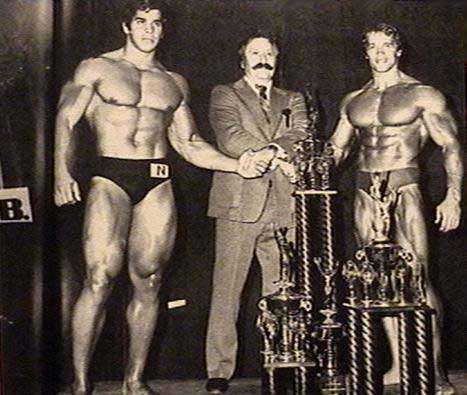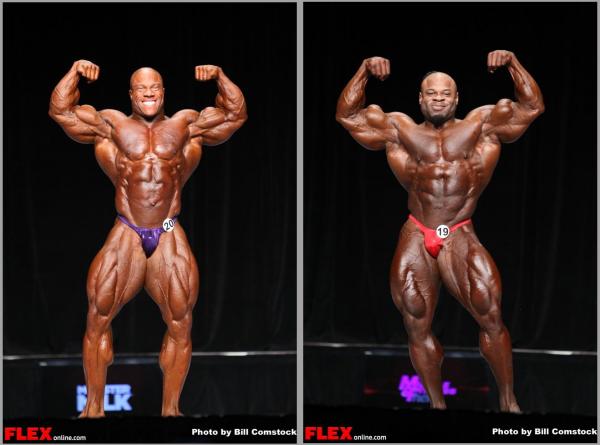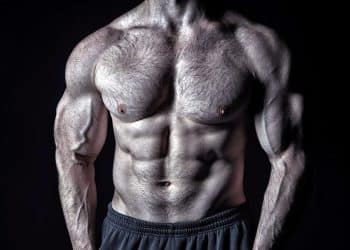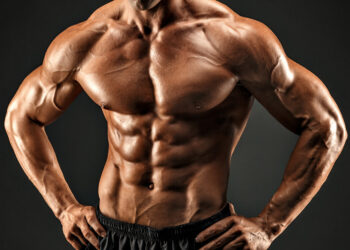Bodybuilders are very detail-orientated exercisers. They target individual muscles to build the most aesthetically pleasing physique possible. That’s not to say muscle size is not important – of course it is! But things like symmetry, balance, and proportion matter too.
After all, the biggest bodybuilder is not guaranteed to be the best one on stage. When it comes to muscle mass, quality is as important as quantity!
So, smart bodybuilders choose exercises that not only play to their strengths but address their weaknesses too.
Sometimes, those weaknesses are genetic, and there is nothing you can do about them. For example, you may have short muscle bellies and long tendons, so your biceps have a great peak, but there is a pronounced gap between the end of the muscle and your elbow.
Level Up Your Fitness: Join our 💪 strong community in Fitness Volt Newsletter. Get daily inspiration, expert-backed workouts, nutrition tips, the latest in strength sports, and the support you need to reach your goals. Subscribe for free!
While you may be able to lessen that gap with exercises like hammer curls, you can’t change the fundamental shape of the affected muscle.
That said, some exercises DO affect different areas of a muscle, so you MAY be able to change its shape slightly. This is bro-science at its best, but in your quest to build the ultimate physique, it’s worth exploring all the options.
So, in this article, we reveal the seven best exercises that could help you develop your outer pecs and provide you with an outer chest specialization workout to try.
Pec Anatomy 101
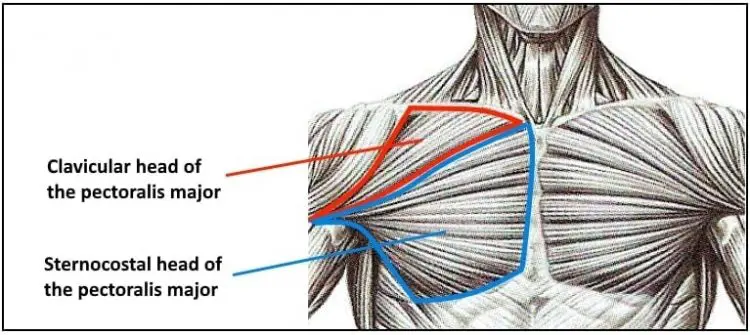
Pectoralis major, or pecs for short, is the large slab of muscle that makes up your chest. There are three sections of fibers or heads that make up your pecs:
- Clavicular head – this is your upper chest. It’s more active during incline movements, such as incline bench press and incline flyes.
- Sternal head – the most prominent pec head, this region forms the bulk of your chest. It’s most active during flat pec exercises, such as flat bench presses and the vertical pec deck.
- Abdominal head – this is your lower chest. Exercises like dips and decline bench presses emphasize this region of your pecs.
While it is impossible to isolate any part of the chest, you can emphasize each head by changing the angle of your upper arms. That suggests that you may also be able to increase inner and outer pec activation by choosing specific exercises.
Exercises that take your pecs through a large range of motion are often felt in the area of the pectoralis major tendon, located in the outer chest. As such, it’s not unreasonable to assume that these exercises may preferentially target this part of the pecs.
Best Outer Pec Exercises
Note
While no scientific studies support the existence of the outer pecs, if you’ve ever done any of the exercises listed in this section, you may well have felt localized tenderness in this area during the following day. While delayed onset muscle soreness (DOMS) is not a reliable indicator of a successful workout, it does suggest that the outer pecs have worked harder than usual.
1. Dumbbell Fly
Dumbbell flyes involve a large range of motion and extending your upper arms far to the side of your body. This provides a deep pec stretch and also puts plenty of tension through the pectorals major’s insertion point – the pectoralis major tendon.
Make this exercise an even better pec builder by pausing in the stretched position for a couple of seconds and, like a lot of old-school lifters used to do, raising your feet. Studies suggest that bench pressing with elevated feet increases pec activation (1), and that may also be the case for dumbbell flyes.
Learn how to do dumbbell flyes here.
2. Cable Fly
Cable and dumbbell flyes are largely interchangeable as they involve the same movement and target the same muscles. However, swapping dumbbells for a cable machine means you can keep your pecs under tension for the entire movement, which may make it a superior pec builder.
Try them both to compare and see if one is better than the other!
Read more about cable flyes here.
3. Cable Crossover
Cable crossovers are basically a standing cable fly. As such, it’s fair to assume it shares many of the benefits of the supine version. That said, with no bench behind your shoulders, you may be able to use a larger range of motion at both the shoulder joint and shoulder girdle, and these joints will be able to move more naturally.
That means the cable crossover may be more shoulder-friendly than cable or dumbbell flyes.
Find out everything there is to know about this great exercise in our in-depth guide.
Level Up Your Fitness: Join our 💪 strong community in Fitness Volt Newsletter. Get daily inspiration, expert-backed workouts, nutrition tips, the latest in strength sports, and the support you need to reach your goals. Subscribe for free!
4. Pec Deck
The pec deck is a machine version of dumbbell and cable flyes. Because the weight is guided on rods, very little coordination or balance is required to do this exercise. That leaves you free to focus on training your pecs to absolute failure in complete safety.
There are two types of pec deck – one where you push with your elbows and another where your arms are extended in front of you, also known as a machine fly. These exercises are pretty interchangeable so try them both to see which one you prefer.
Read more about the pec deck here.
5. Chest Dip
Dips are usually viewed as a lower pec or triceps exercise. However, if you use a wide grip and flare your elbows outward, you should feel this exercise in the area around the pectoralis major tendon.
Be warned; chest dips can also cause shoulder pain, so introduce this exercise gradually to your workouts and avoid descending too deeply.
How to do it:
- Use dipping bars that are wider than shoulder-width apart. The narrower your grip, the less chest engagement there will be.
- Place your hands on the bars with your palms turned inward. Support your weight on straight arms.
- Bend your knees and push your legs and hips as far back as you can. The greater the incline, the more pec activation there will be.
- Bend your arms and descend as far as you can without hurting your shoulders. Get a good stretch in your pecs. Allow your upper arms and elbows to flare outward.
- Extend your elbows and push yourself upward, stopping just short of lockout to keep the tension on your pecs. Push inward as well as downward to maximize pec engagement.
- Descend and repeat.
Read more about the difference between triceps and chest dips here.
6. Wide-grip Bench Press
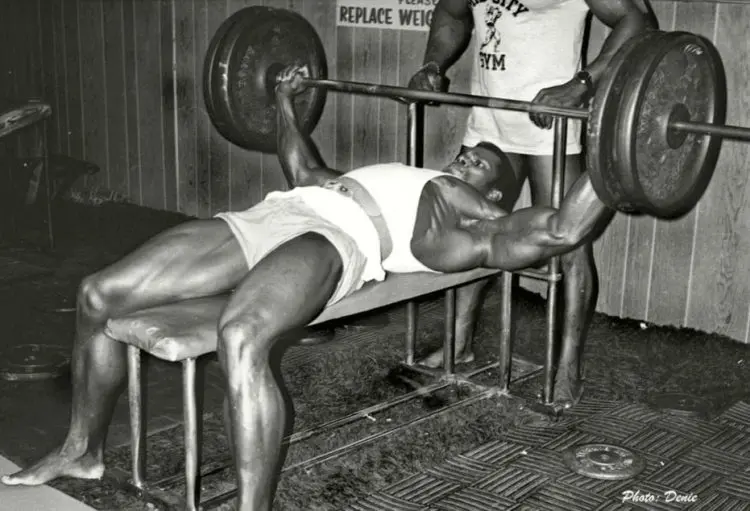
The wider you place your hands during bench presses, the more they resemble pec flyes. As such, it’s a safe bet that wide-grip bench presses affect your outer pecs. Putting your hands further apart than usual should also produce a good stretch on your chest. Pause with the bar lightly touching your chest to make this exercise even more effective.
Take care not to go too heavy too soon with this exercise, as doing so could result in shoulder pain.
Learn how to do wide-grip bench presses here.
7. Wide Deficit Push-ups
No barbell, dumbbells, or pec deck? No problem! You can replicate the effects of these exercises by doing wide, deficit push-ups. This exercise is an excellent option for anyone who works out at home or simply prefers bodyweight training.
It also makes for a fantastic finisher after a weight-based chest workout. Crank out 50-100 reps in as few sets as possible for a phenomenal chest pump.
How to do it:
- Place a couple of dumbbells, bumper plates, yoga blocks, or push-up handles on the floor, so they’re 5-8 inches outside shoulder-width apart.
- Squat down and place your hands on the raised implements.
- Walk your feet out and back until your legs and hips are straight. Brace your core and pull your shoulders down and back.
- Bend your arms and lower your chest down between your hands. Descend far enough to get a stretch in your pecs. Keep your elbows out and away from your sides.
- Push yourself back up and then repeat.
- Make this exercise easier by bending your legs and resting on your knees. Or harder by raising your feet or wearing a weighted vest.
Related: 15 Intense Push-Up Variations for Bodybuilders
Outer Pec Workout
While you could just do a few random outer chest exercises and hope that you get good results, you’ll probably do better if you use a more structured routine. So, do this workout 1-2 times a week for the next 4-6 weeks to see if you really can increase outer pec mass.
Be your own experiment and post your results below!
| No: | Exercise | Sets | Reps | Recovery |
| 1 | Wide-grip bench press | 4 | 6-8 | 2 minutes |
| 2 | Chest dip | 3 | 8-10 | 90 seconds |
| 3 | Cable fly | 3 | 10-12 | 60 seconds |
| 4 | Dumbbell fly | 2 | 12-15 | 60 seconds |
| 5 | Wide deficit push-ups | 1 | 100 | N/A |
Wrapping Up
According to anatomists, there is no such thing as the outer pecs, and, even if there were, there is no way to isolate them. However, bodybuilders have been using exercises like dumbbell flyes and wide-grip bench presses to target this mythical area for years, suggesting that bro-science may be one step ahead of the guys in the laboratories.
Whether you are a believer or not, there is no denying that an intense set of cable crossovers or pec decks can leave the area around your pectoralis major tendons feeling sore, which indeed suggests something interesting is happening in that region.
So, start doing more of these outer pec exercises and try our workout to see if you really can increase outer pec mass.
References:
1 – PubMed: Evaluation and comparison of electromyographic activity in bench press with feet on the ground and active hip flexion https://www.ncbi.nlm.nih.gov/pmc/articles/PMC6568408/

